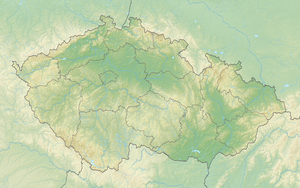Stoupec
| Stoupec | ||
|---|---|---|
| Creation time : | 14th Century | |
| Conservation status: | Burgstall, well-preserved rampart and moat | |
| Place: | Březinka | |
| Geographical location | 49 ° 55 '9.9 " N , 15 ° 34' 20.4" E | |
| Height: | 455 m nm | |
|
|
||
The Postal Stoupec (Czech tvrziště Stoupec ) is an Outbound Wasserburg plant in iron mountains ( Iron Mountains ) in the Czech Republic . It is located one and a half kilometers south of Březinka in a wooded area in the Okres Chrudim . For a long time, the Burgstall was viewed as a desolate Augustinian monastery .
location
Stoupec lies off the beaten track in the forest between the villages of Březinka, Slavkovice , Jetonice and Licoměřice at the source of the Mlýnský creek in the protected landscape area CHKO Železné hory. The Honzíkův vrch (508 m nm) rises to the southeast, the Skála (490 m nm) in the southwest.
history
The fortress of Stoupec was probably built during the reign of King Charles I on the Vicemilicer Pass near the cross of five paths as a guard station in the Iron Mountains, which are considered unsafe. The pass was the most passable connection from the Czaslau basin into the mountains and to the nearby Strenitzer Steig between Bohemia and Moravia. One route led from Lipovec to Jezírka, the other from the village square by the church of Vicemilice dolní , a deep ravine now known as Myší díra ( Mouse Hole ) into the mountains to Vícemilice horní ; In addition, on the steep climbs, surrounding paths were created, which over the years have been turned into ravines.
The fortress was first mentioned in writing in 1389 as the property of Slaměnec von Urbanice . The first evidence of the Stoupec court was made in 1394, when King Wenceslaus IV left the court, which had fallen back after the death of Jan von Milíčeves, to Jan Chrást of Stoupec. At the beginning of the 15th century, Kunka von Vícemilice claimed the fortress. In 1419 Držek von Kratonosy left the Stoupec farm with a share from Hošťalovice to Jan von Čejkovice.
The fortress, as well as the nearby six-house village of Hody, was probably destroyed in 1469 during the Bohemian-Hungarian War when Matthias Corvinus's troops invaded Bohemia. In 1486 the Stoupec fortress was described as desolate. The desert festival was last mentioned in a document in 1559. After that, it was forgotten.
In the 17th or 18th century the legend emerged that there was once a monastery on the castle wall in the forest. In 1843 a description of the village of Březinka under the Podhořan estate read:
“In the neighboring forest of Strupy one can still find traces of a former monastery of regulated Augustinian canons which was destroyed in an unknown time. The Podhořan estate still pays 23 fl. 20 kr annually under the name "Karlshöfer Kammerzins". to the attention of the kk religious fund. This tax probably stems from a liability of the former owners against the destroyed monastery, whose spiritual residents may have been members of the Prague Augustinian monastery at Karlshofe. "
August Sedláček proved through source research in 1865 that the Stoupec fortress was located on the site of the supposedly desolate monastery.
With the completion of the new road between Starý Dvůr and Nový Dvůr in 1906, the old paths that crossed at the castle stables lost all meaning.
description
The well-preserved round castle stable with a total diameter of 30 m is surrounded by a deep ring moat. It lies on a flat terrain, gently sloping towards the south, between the valleys of the Struha and Starkočský potok. To the south, the complex was additionally protected with an outer wall. The ring moat was probably fed by small watercourses, the course of which can still be seen in the area southeast of the castle stables; possibly the water supply came from the struha, since there are no springs above the system.
On the area of the mighty inner hill there are large amounts of rock fragments, which suggest that part of the complex was stone. Since almost no remains of the interior structures have survived, it is very likely that they were made of wood. To the west of the ring moat, the wall remains of some smaller buildings with cavities in cellars have been preserved; access to the fortress was probably made from this side via a bridge.
There was no source within the facility. A wooden well north of the wall at one of the springs of the Mlýnský potok served as the drinking water supply for the crew. A few meters northwest of the fortress, there was also a cattle trough at Mlýnský potok; the small rectangular pond was there until the 1960s, today there is a swamp overgrown with aspens. Approx. 500 m northeast of the castle stables are the remains of two smaller fish ponds in the V rybníčkách corridor .
The remains of the Stoupec farm and the medieval village of Hody are believed to be south and east of the castle stables, respectively.
